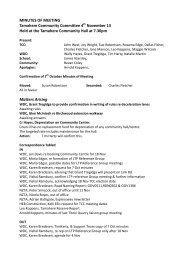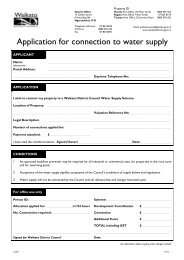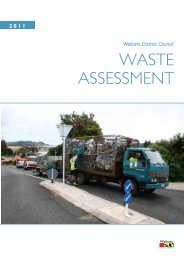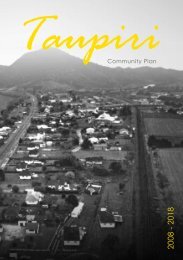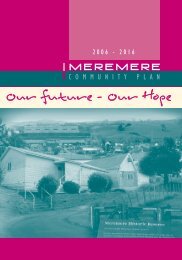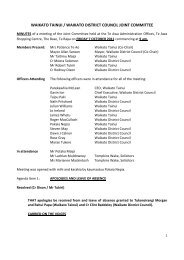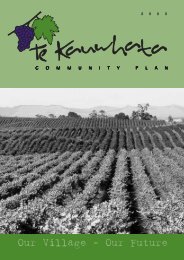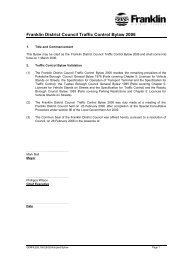1% - Waikato District Council
1% - Waikato District Council
1% - Waikato District Council
- No tags were found...
Create successful ePaper yourself
Turn your PDF publications into a flip-book with our unique Google optimized e-Paper software.
30NAVIGATING THE FUTURE | WAIKATO DISTRICT COUNCILWe want to see positive growth and encourage economicdevelopment in the district. At the same time, simplymaintaining what we have will cost more.The council presently has a low level of debt. Keeping in mindrates affordability and sustainability, our policy is to maintain arelatively low debt level, but also to increase borrowing to helpus achieve what’s needed to provide for growth and ensure oureconomy doesn’t stagnate. For example, we will fund some ofthe new infrastructure at Pokeno through borrowing.However, the cost of our operations is increasing. Should wekeep our standards of services at their present levels, shouldwe improve them further (at a cost), or accept lower standardsand therefore a lower cost for them? For instance, roads not atthe same high level of construction and up-keep as in the restof the district will be gradually upgraded. We also are absorbingparts of what will be the former SH1, SH1b and SH39 intoour local roads, which means we have to pay the cost of theirmaintenance.Over the past few years, we have had the advantage of being ina competitive contracts market. We will have to prepare for anupturn sometime in the period of this plan, where this marketadvantage won’t apply.The following pages contain financial information and discussionaround how we will maintain what we have and prepare forfuture needs.Planning for growthThis Long Term Plan takes into account expected growth,regional pressures and predicted change. <strong>Waikato</strong> district isrich in food, energy and mineral resources. By providing ourneighbours with sustainable resources, we also provide forour own population and economic growth.Three factors in particular have a direct effect on this LongTerm Plan• The development of Pokeno• <strong>Waikato</strong> Expressway completion by 2019• Changes to the <strong>District</strong> Plan, leading to changes to theurban:rural population mix.Changes to the <strong>District</strong> Plan, leading to changes to the urban:rural population mix.Projected changes in population and land use2012 2022 ChangeEstimated population 65,114 77,331 12,217Estimated dwellings 23,240 27,975 4,735Estimated urban: rural mix 47:53 49:51These growth estimates are from our detailed populationmodelling prepared in conjunction with the National Instituteof Demographic and Economic Analysis, and includes baseinformation from the 2006 census. The 2010 census waspostponed because of the Canterbury earthquakes.This modelling has been used to assess the capital andoperational spending needed to meet these demands. Youcan find a summary of the growth tables in the significantforecasting assumptions, as well as our estimates of the impactson this plan if our population growth assumptions are wrong.The 2007 Local Government Rates Inquiry which resulted inthe ‘Shand Report’ made some key points which we have keptin mind in developing this Long Term Plan.The inquiry examined the sustainability and affordability of ratesfor low-income groups.Sustainable funding is defined as: Funding arrangements thatare affordable over time without causing intergenerationalinequities. In other words, today’s ratepayers don’t have to payan unequal share of council spending which will benefit futuregenerations, and vice versa.Rates affordability is having enough income to pay the rateswithout serious economic difficulty.BERL (Business and Economic Research Limited) predictedrates per rateable property would increase by 4.45 per centper year to 2016.However, median household income would increase by 3.28per cent, which means the average rates burden would increase1.17 per cent each year.The report estimates the top limit for rates affordability iswhere rates are over 5 per cent of the gross household income(income before tax).It highlights many aspects of affordability, including the linksbetween housing affordability and rates affordability, andhow rates affect income-poor: asset-poor and income-poor:asset-rich ratepayers



